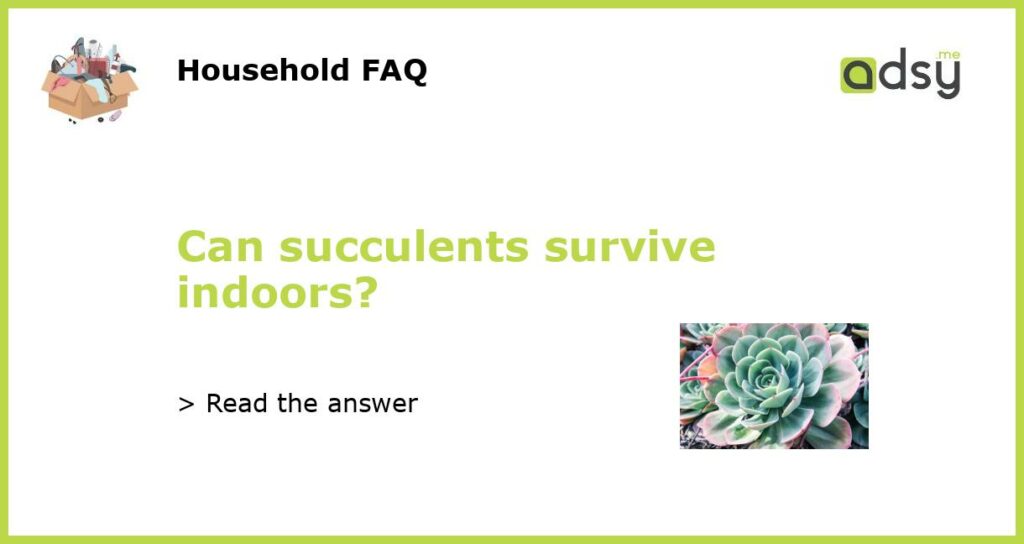Yes, succulents can survive indoors
Succulents are a popular type of plant due to their unique and beautiful appearance, low maintenance requirements, and ability to thrive in various environments. While they are often associated with outdoor gardens and arid climates, many succulents can also thrive indoors. In fact, there are numerous succulent species that are well-suited for indoor living.
Why are succulents well-suited for indoor environments?
Succulents have specific traits that make them adaptable to indoor environments. One of the key factors is their ability to store water in their leaves, stems, and roots. This adaptation allows them to withstand dry indoor conditions and thrive without frequent watering. Additionally, succulents have slow growth rates and do not require a large amount of space, making them ideal for indoor settings.
What are the key factors to consider for indoor succulent care?
While succulents can survive indoors, there are a few key factors to consider for their care and well-being.
Light: Succulents require bright light to thrive. Place them near a south or east-facing window to ensure they receive sufficient sunlight. If natural light is limited, you can also use artificial grow lights to supplement their light needs.
Temperature and humidity: Most succulents prefer warm temperatures between 60-80°F (15-27°C). They can tolerate lower temperatures but may require additional protection. Succulents do well in average indoor humidity levels, but some species may benefit from increased humidity in drier environments. You can achieve this by placing a tray of water near their location or using a humidifier.
Watering: While succulents can tolerate dry conditions, they still need water to survive. Water them thoroughly but infrequently, allowing the soil to dry out between waterings. Overwatering is one of the most common causes of succulent death, so it’s important to avoid this by using well-draining soil and pots with drainage holes.
Soil and potting: Succulents need well-draining soil to prevent root rot. Choose potting mixes specifically formulated for succulents or create your own by mixing regular potting soil with perlite or sand. Additionally, select pots with drainage holes to allow excess water to escape.
Which succulents are best for indoor environments?
While many succulents can thrive indoors, some species are better suited for the lower light and temperature conditions typically found in indoor environments.
Some popular indoor succulents include:
- Hens and Chicks (Sempervivum spp.): They come in a variety of colors and form rosettes that produce smaller rosettes around the base, giving them their unique name.
- Jade Plant (Crassula ovata): Known for its thick, fleshy leaves and tree-like appearance, the Jade Plant is a popular choice for indoor cultivation.
- Ponytail Palm (Beaucarnea recurvata): Despite its name, the Ponytail Palm is not a true palm but a succulent. It features long, slender, and arching leaves that give it a unique appearance.
- African Milk Tree (Euphorbia trigona): This succulent has tall, segmented stems adorned with small leaves, making it an eye-catching addition to any indoor space.
- Snake Plant (Sansevieria trifasciata): Snake Plants are known for their upright, sword-shaped leaves with striking patterns. They are incredibly hardy and can tolerate a wide range of light conditions.
Can all succulents survive equally well indoors?
While most succulents can adapt to indoor environments, not all species will thrive equally well indoors. Some succulents have specific light, temperature, or humidity requirements that are challenging to recreate indoors. Additionally, certain succulents may grow too large for indoor spaces or require more intense sunlight.
It’s essential to consider the specific needs of each succulent species before bringing them indoors. Research their light, temperature, and humidity requirements to ensure you can provide the optimal conditions for their growth and well-being. Consulting with a knowledgeable plant specialist or using online resources can help you determine which succulents are best suited for indoor cultivation.






